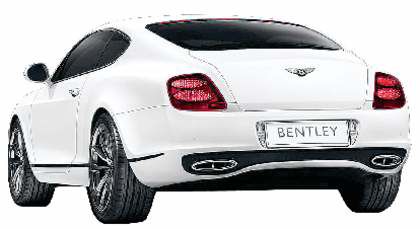The (curious) supercar of tomorrow? You bet
Published 5:00 am Sunday, October 25, 2009

- The Bentley Continental Supersports coupe is a car embracing extremes. It boasts maximum power and speed with a minimized contribution to global warming. It's part luxury car, part science project.
MILFORD, Pa. — The Bentley Continental Supersports coupe is a car embracing extremes — maximum power and speed with a minimized contribution to global warming.
As such, it is a high-performance green automobile — equipped with a 621-horsepower, 12-cylinder engine. It moves from 0 to 60 miles per hour in 3.7 seconds — burning petroleum or using alcohol derived from food crops, or from industrial or agricultural wastes.
The Supersports performs splendidly at racing venues, such as the Monticello Motor Club, a country club with a 4.1-mile racetrack, 90 minutes from Manhattan and a drive of nearly equal duration from this quiet hamlet in Pennsylvania’s Pike County.
But the Supersports also does well when autumn weather in these parts turns chilly and damp, lacing the landscape with lots of slippery roads.
It is a curious automobile — part luxury ride, part science project, the progeny of a small group of engineers and designers given generous leeway to experiment with new technologies, materials and fuels in pursuit of a daily-use automobile with racetrack prowess and environmental bragging rights.
“It began as an experiment,” said Brian Gush, director of engineering for the underpinnings (chassis, engines, transmissions) of Bentley cars.
Bentley’s parent company, Volkswagen of Germany, wants to reduce the environmental burden of Bentley cars without harming Bentley’s reputation for speed and handling. It is an engineering conundrum created by governments worldwide demanding more environmentally friendly automobiles.
The trick for Bentley and other manufacturers of exotic automobiles — including Italy’s Lamborghini and Ferrari — is to deliver those cars without destroying what originally made them desirable.
Bentley’s engineers and designers attacked the problem by attacking weight — substituting carbon fiber and other high-strength, lightweight materials wherever possible — notably in the car’s two seats, which are thin but elegantly stitched and comfortable and ensconced in carbon-fiber shells.
Strong but lighter-weight chassis components were used where practicable. Carbon-ceramic brakes — strong, sure, expensive — were added as standard equipment. A six-speed automatic transmission, which also can be shifted manually, was redesigned to shift 50 percent faster with discernibly less effort than its predecessor.
When all of the experimenting and tinkering was done, the result was something the folks at Volkswagen and Bentley had not expected — “the extreme Bentley,” they called it, the Supersports — the fastest Bentley ever, but one that, ironically, is also the cleanest and one of the least guzzling Bentleys ever at 12 miles per gallon in the city and 19 miles per gallon on the highway.
When fueled with 85 percent ethanol, increasingly available at service stations in the United States, the Supersports produces 70 percent less globally warming carbon dioxide. That’s a well-to-wheel estimate, meaning the amount of carbon dioxide emitted from ethanol production to delivery to the Bentley’s fuel tank, and through the car’s burning and exhaustion of that fuel. Critics understandably will cite that as semantic gaming. But, from this column’s perspective, it’s a big step in the right direction.
It’s an expensive car, one that probably will cost considerably north of $250,000 when its actual retail prices are set. Understandably, that also will set many eyes to rolling. (And, yes, I freely admit that I drove the thing simply because I had the opportunity to come here and do so.)
But, again, keep in mind that Bentley’s parent company is Volkswagen, and that Volkswagen has grand plans to topple Toyota from its perch as the world’s largest car company. Volkswagen plans to do that via innovation — turning seemingly exotic technologies into affordable standard equipment on mainstream cars. That means the Bentley that turns you green today could be the Volkswagen you drive tomorrow.
The bottom line
It’s extreme, and I love it. If you drive it, you’ll love it, too. It and cars like it are why private motor raceways exist.
Complaint: The people who can afford the Supersports aren’t terribly worried about costs for gasoline or ethanol. They therefore are not bothered by the Supersports’ still-egregious fuel consumption.
Head-turning quotient: It is assumed that if you can afford this car, you also can afford the best of lawyers. Either that or you will keep this car on the track. On the highway, it’s a head-turning, ticket-writing magnet for police.
Capacities: Two seats for two people. Maximum cargo capacity is 13 cubic feet. The fuel tank holds 23.8 gallons of gasoline, 85 percent ethanol, or any combination of gasoline and ethanol.
Safety: Standard equipment includes cross-drilled carbon-ceramic disc brakes front and rear, anti-lock brake protection and electronic brake-force distribution, side and head air bags, electronic stability and traction control.
2010 Bentley Continental Supersports coupe
Estimated price: $275,000, on sale this fall
Type: Luxury, front-engine, all-wheel-drive, two-seat sports coupe, designed primarily for high-performance driving, preferably on a track
Engine: 6-liter, W-12 engine (think of two V-6 engines joined)
Mileage: 12 mpg city, 19 mpg highway






